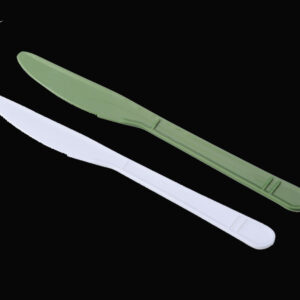With the deterioration of the global climate and environment, people pay more and more attention to environmental issues, so all walks of life have begun the trend of environmental protection. In the restaurant industry emerged a variety of environmentally friendly tableware. Corn starch tableware is one of the categories. Corn starch tableware is the use of corn starch raw materials to produce tableware. It can be completely biodegradable and recycled, which aligns with the theme of environmental protection tableware. In this article, we will share the advantages and disadvantages of cornstarch tableware.

Advantages of cornstarch tableware.
Cornstarch offers several significant benefits as a sustainable material compared to ordinary plastics.
Carbon Neutral
Because of the carbon consumed by the corn plant during growth, the net emissions from corn starch production are low, making it a net carbon-neutral material.
Renewable
Corn starch is a renewable feedstock that can be replaced repeatedly in the ground, unlike fossil fuel-derived oil. Suppose farming and processing practices around corn production can be developed to reduce its environmental externalities. In that case, it could become a more desirable input to plastics production than the marginal input it currently is.
Biodegradable
The great advantage of corn starch over ordinary plastics is that it is biodegradable in as little as 90 days under the right conditions.
Food Safety
Cornstarch plastic is approved by the FDA as 100% safe for food packaging resistant to oily foods, making it an excellent alternative to traditional plastic packaging in restaurant takeout or similar products. By 2025, biodegradable packaging is expected to represent a $121 billion industry.
Non-Toxic
Bioplastic made from corn starch does not release harmful toxins when it biodegrades. It is also free of bisphenol A (BPA), a hormone disruptor typically found in conventional plastics.
What are the disadvantages of corn starch?
Although corn starch is compostable, an obvious caveat to all the frantic marketing of corn starch products is that they can only be composted in industrial facilities and not at home. This is because composting corn starch requires higher heat (140 degrees Fahrenheit) than a home composting setup, as well as the presence of specific microorganisms to facilitate the process.
Why is this a disadvantage? Because when we consider the national recycling rate in the United States (only 9% of plastics are recycled), the process is less likely to occur, and the process itself consumes additional energy. For example, in the operation of specialized machinery and the more extensive waste management infrastructure required to collect and manage it. Another disadvantage is that the output of the compost is not immediately usable. It is so acidic that it requires expensive alkali treatment to be safe for the soil.
Using corn in bioplastics and biofuels has other unintended consequences, such as detracting from the plant’s use as a food crop. Some populations worldwide depend on corn for their food supply, and increased demand for corn for bioplastics could lead to a global food crisis.
Because of the complex processing stages of corn starch, PLA can be expensive to produce, about 20 – 50% more than conventional plastics. However, progress is being made in improving the production process and closing the gap.
If you are interested in learning more about corn starch tableware or want to customize corn starch tableware, you are welcome to contact a professional corn starch tableware manufacturer – Hengfeng.







